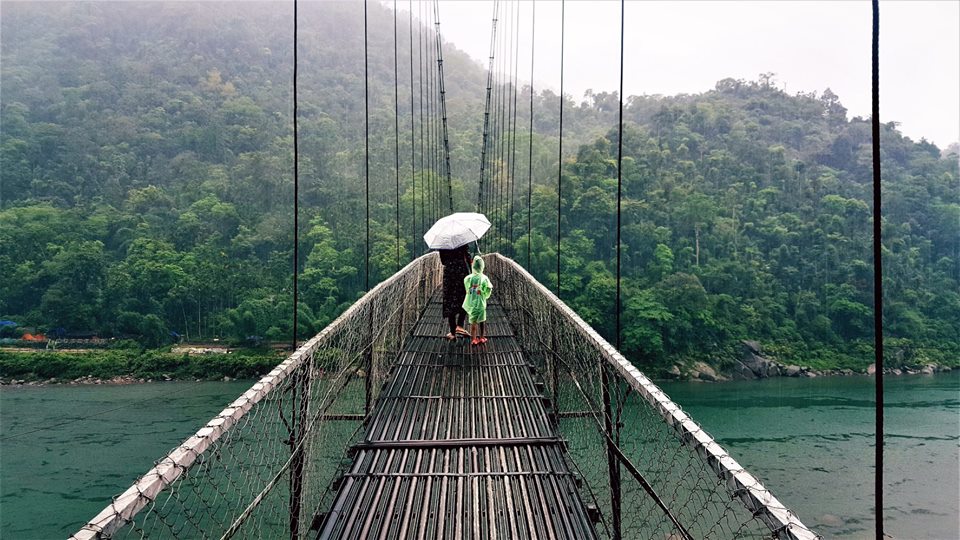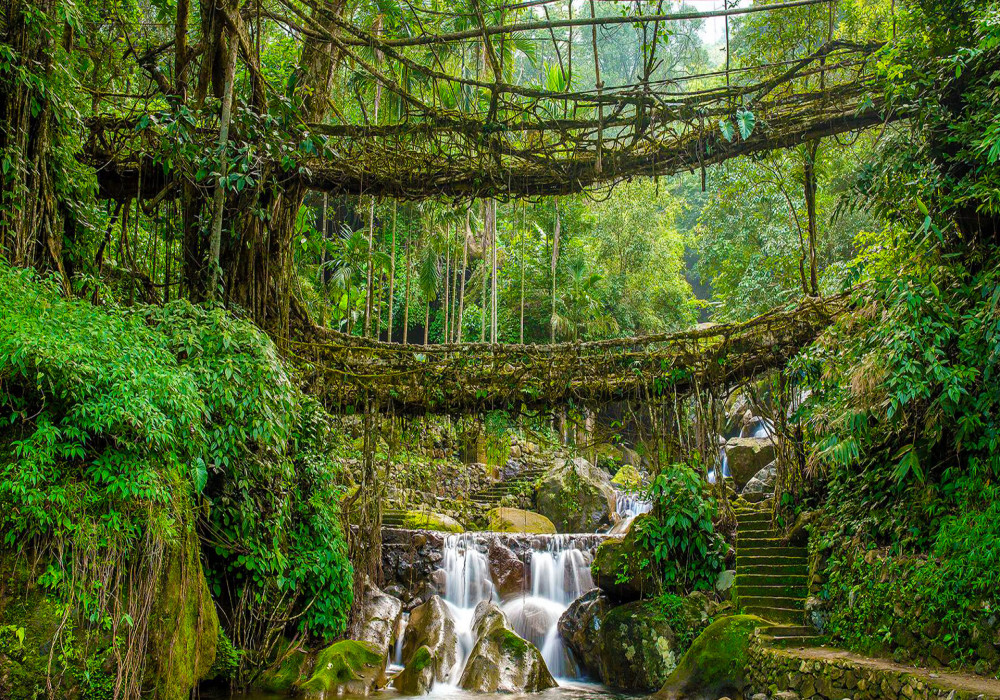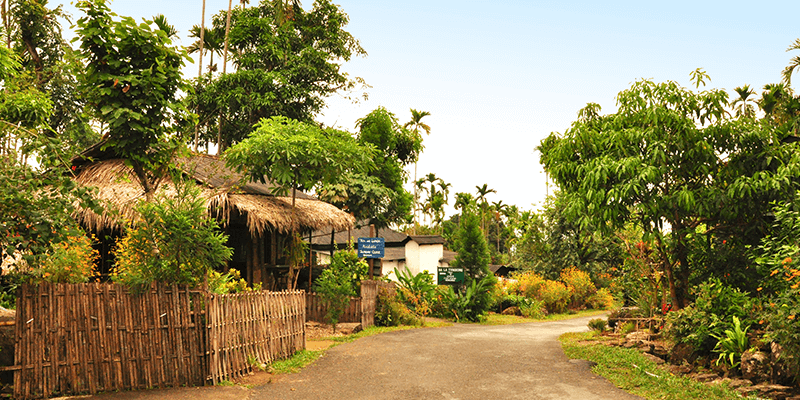4Nights 5 Days View offer details
4N/5D accommodation Stay valid all days except peak season. Half day city tour Paying for food Is compulsory and it includes unlimited dinner and breakfast. 7 days prior booking should be confirmed
Validity : All days
6 Nights 7 Days View offer details
6N/7D accommodation Stay valid all days except peak season. Half day city tour Paying for food Is compulsory and it includes unlimited dinner and breakfast. 7 days prior booking should be confirmed
Validity : All days
No OFFER AVILABLE AT THIS TIME.
........
- Overviews
- Amenities
- FAQ
Meghalaya, a Sanskrit word meaning “the abode of cloud“, was created as an autonomous State on 2nd April 1970. The full-fledged State of Meghlaya came into existence on 2nd January 1972. Meghalaya has precise historic, geographic and strategic significance for India. It is bound on north and east by the state of Assam, and on south and west by Bangladesh. The three physical division in the state are Garo (Western), Khasi (Central) and Jaintia (Eastern) hill divisions.
In the Garo hills, the Tura range occupies dominantly a middle portion running west to east where the Nokrek peak is located. Khasi -Jaintia ranges are interwined with a curved-alignment. Spurs of ranges in Jaintia hills are shorter in height than the Shillong Plateau; hillbases lie side by side with flat lands, valley and meadows.
Meghalaya is endowed with a rich variety of flora and fauna. Of about 17,000 species of orchids in the world, around 3000 varieties are found in Meghalaya. A botanical wonder, the pitcher plant, an insect eating plant is found in the district of Jaintia hills, West Khasi hills and South Garo hills of the state. Animals and birds that are found in the state are elephants, tigers, bear, jackal, leopard, golden langurs etc .
Meghalaya, a Sanskrit word meaning “the abode of cloud“, was created as an autonomous State on 2nd April 1970. The full-fledged State of Meghlaya came into existence on 2nd January 1972. Meghalaya has precise historic, geographic and strategic significance for India. It is bound on north and east by the state of Assam, and on south and west by Bangladesh. The three physical division in the state are Garo (Western), Khasi (Central) and Jaintia (Eastern) hill divisions.
In the Garo hills, the Tura range occupies dominantly a middle portion running west to east where the Nokrek peak is located. Khasi -Jaintia ranges are interwined with a curved-alignment. Spurs of ranges in Jaintia hills are shorter in height than the Shillong Plateau; hillbases lie side by side with flat lands, valley and meadows.
Meghalaya is endowed with a rich variety of flora and fauna. Of about 17,000 species of orchids in the world, around 3000 varieties are found in Meghalaya. A botanical wonder, the pitcher plant, an insect eating plant is found in the district of Jaintia hills, West Khasi hills and South Garo hills of the state. Animals and birds that are found in the state are elephants, tigers, bear, jackal, leopard, golden langurs etc .
Meghalaya, a Sanskrit word meaning “the abode of cloud“, was created as an autonomous State on 2nd April 1970. The full-fledged State of Meghlaya came into existence on 2nd January 1972. Meghalaya has precise historic, geographic and strategic significance for India. It is bound on north and east by the state of Assam, and on south and west by Bangladesh. The three physical division in the state are Garo (Western), Khasi (Central) and Jaintia (Eastern) hill divisions.
In the Garo hills, the Tura range occupies dominantly a middle portion running west to east where the Nokrek peak is located. Khasi -Jaintia ranges are interwined with a curved-alignment. Spurs of ranges in Jaintia hills are shorter in height than the Shillong Plateau; hillbases lie side by side with flat lands, valley and meadows.
Meghalaya is endowed with a rich variety of flora and fauna. Of about 17,000 species of orchids in the world, around 3000 varieties are found in Meghalaya. A botanical wonder, the pitcher plant, an insect eating plant is found in the district of Jaintia hills, West Khasi hills and South Garo hills of the state. Animals and birds that are found in the state are elephants, tigers, bear, jackal, leopard, golden langurs etc .
Meghalaya, a Sanskrit word meaning “the abode of cloud“, was created as an autonomous State on 2nd April 1970. The full-fledged State of Meghlaya came into existence on 2nd January 1972. Meghalaya has precise historic, geographic and strategic significance for India. It is bound on north and east by the state of Assam, and on south and west by Bangladesh. The three physical division in the state are Garo (Western), Khasi (Central) and Jaintia (Eastern) hill divisions.
In the Garo hills, the Tura range occupies dominantly a middle portion running west to east where the Nokrek peak is located. Khasi -Jaintia ranges are interwined with a curved-alignment. Spurs of ranges in Jaintia hills are shorter in height than the Shillong Plateau; hillbases lie side by side with flat lands, valley and meadows.
Meghalaya is endowed with a rich variety of flora and fauna. Of about 17,000 species of orchids in the world, around 3000 varieties are found in Meghalaya. A botanical wonder, the pitcher plant, an insect eating plant is found in the district of Jaintia hills, West Khasi hills and South Garo hills of the state. Animals and birds that are found in the state are elephants, tigers, bear, jackal, leopard, golden langurs etc .
1. Pickup and Drop-off Services
- Airport/Railway Station Transfers
2. Local Transportation
- Sightseeing in Sedan Car
3.. Accommodation
- Hotels
4. Meals
- Daily Breakfast
- Lunch or Dinner
5. Tour Guide
- Professional Guides
- Language Options
6. Sightseeing Tours
- Itinerary
7. Cultural Experiences
- Local Performances
8. Assistance and Support
- 24/7 Assistance
Frequently Asked Questions?
-
2. How do I reach Meghalaya?
The nearest major airport to Meghalaya is Lokpriya Gopinath Bordoloi International Airport in Guwahati, Assam. From Guwahati, you can take a taxi or a pre-arranged transfer to Shillong, the capital of Meghalaya, which is approximately 100 kilometers away.
-
1. What is the best time to visit Meghalaya?
The best time to visit Meghalaya is between October and April when the weather is pleasant and the region experiences less rainfall. This period is ideal for sightseeing, outdoor activities, and exploring the natural beauty of the state.
-
12. What are the local languages spoken in Meghalaya?
The primary languages spoken in Meghalaya are Khasi, Garo, and Jaintia. English and Hindi are also widely understood and spoken, especially in urban areas and tourist spots.
-
3. What kind of accommodations are available in Meghalaya?
Meghalaya offers a range of accommodations, including: Hotels (3-star to 5-star) Resorts Homestays Guesthouses Camping options (in certain areas)
-
4. What are the must-visit places in Meghalaya?
Some of the must-visit places include: Shillong Cherrapunjee (Sohra) Mawlynnong (the cleanest village in Asia) Dawki (Umngot River) Living Root Bridges (Nongriat, Riwai) Laitlum Canyons Mawsynram (one of the wettest places on earth) Jowai (Krang Suri Falls)
-
6. Do I need a tour guide?
While it is possible to explore Meghalaya independently, having a local tour guide can enhance your experience by providing insights into the culture, history, and hidden gems of the region. Guides are particularly helpful for trekking, caving, and understanding local customs.
-
7. What should I pack for a trip to Meghalaya?
Comfortable clothing suitable for varying weather conditions Rain gear (especially if visiting during the monsoon season) Sturdy walking shoes or trekking boots Personal medications and a basic first aid kit Camera and binoculars for bird watching and sightseeing Sunscreen, sunglasses, and hats A reusable water bottle
-
5. What activities can I do in Meghalaya?
Meghalaya offers a variety of activities, such as: Trekking (Living Root Bridges, David Scott Trail) Caving (Mawsmai Cave, Liat Prah Cave) Boating (Umngot River in Dawki) Zip-lining Camping Exploring waterfalls and natural landscapes Visiting local markets and cultural sites
-
10. What kind of transportation is available within Meghalaya?
Private Taxis: Common and convenient for traveling between towns and attractions. Shared Taxis: Economical option for local travel. Buses: Available but may be less frequent and slower. Rental Cars: Available for those who prefer self-driving (ensure you have a valid driving license).
-
8. Is Meghalaya safe for tourists?
Meghalaya is generally safe for tourists. However, it is advisable to follow standard travel precautions such as not venturing into unknown areas alone at night, keeping valuables secure, and being aware of your surroundings.
-
11. Is there internet and mobile connectivity in Meghalaya?
Major towns and tourist areas generally have good mobile connectivity and internet access. However, connectivity may be limited in remote areas and during trekking or caving activities.
-
9. What is the local cuisine like in Meghalaya?
Meghalaya's cuisine includes a variety of local dishes such as Jadoh (rice cooked with meat), Dohneiiong (pork cooked with black sesame seeds), Tungrymbai (fermented soybean), and a variety of fresh vegetables and fruits. Both vegetarian and non-vegetarian options are available.


